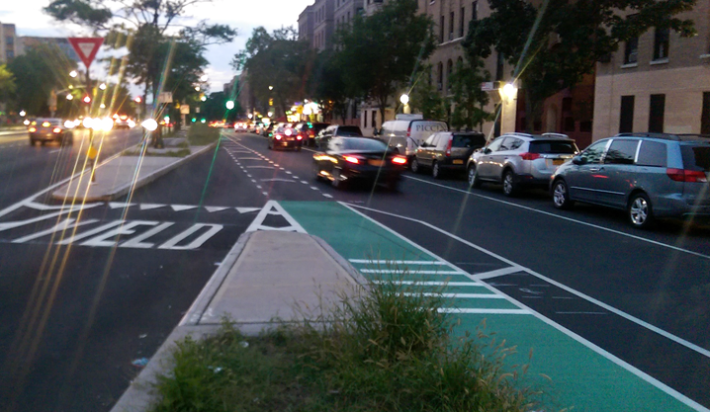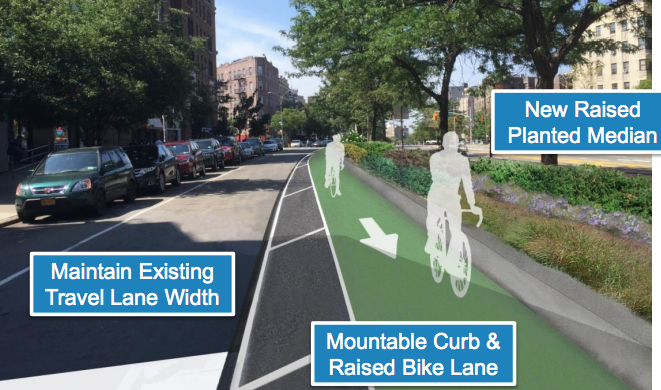Earlier this week, DOT unveiled plans for the fourth and final phase of its reconstruction of the Grand Concourse, which will cover a little more than a mile, from 175th Street to Fordham Road [PDF].
The project got a thumbs up from Bronx Community Board 5's municipal services committee, but it's not scheduled for completion until 2022. The long wait stands in contrast to similar projects in Brooklyn and Queens, which DOT implements quickly with paint and other low-cost materials before the more time-intensive capital construction process builds out changes with permanent materials.
Similar to the design for phases two and three, the fourth phase of the Grand Concourse project will shift bike lanes on the service roads from the curb to the median, raising them above the grade of motor vehicle lanes. Motorists exiting the Concourse's central roadway will have to come to a full stop before crossing the bike lane and entering the service road.
The Grand Concourse is a major transit street and north-south connection for some of the most densely populated neighborhoods in the city. With wide car lanes, long pedestrian crossings, and high-speed slip lanes between the main roadway and the service roads, it's also one of New York's most dangerous streets.
For two years, a coalition of community groups, churches, and elected officials has pressed NYC DOT for a "complete street" redesign of the boulevard including protected bike lanes, shorter crossings, and dedicated bus lanes.

Last summer, in a preliminary version of phase two of the Concourse redesign, DOT realigned the bike lanes between 166th Street and 171st Street to the left side of the service roads and painted them green. The bike lane is less susceptible to getting blocked by illegal parking, but points of high-speed conflict remain where drivers transition between the main road and service lanes (above).
DOT's phase four redesign addresses that problem by controlling those transitions with stop signs:
But DOT has no plans to expedite the improvements by implementing a preliminary version with low-cost materials, as the city has done on Queens Boulevard, one of the de Blasio administration's other flagship "Vision Zero Great Streets" projects. Instead, Bronxites will have to wait for the Department of Design and Construction's notoriously slow and unreliable capital reconstruction process. Phase four is slated to begin construction in 2019 and wrap up a full three years later.
"It's possible we won't see progress until 2022," said Transportation Alternatives Bronx organizer Erwin Figueroa. "Waiting multiple years to see safety improvements doesn't make any sense."
Despite a broad, active neighborhood coalition to improve the Concourse for walking, biking, and transit, the city isn't showing the same responsiveness on the Concourse as it has in Queens and Brooklyn. Each phase of the Queens Boulevard redesign, for instance, is implemented with low-cost materials the same year that DOT presents it. DOT also took care to improve its Fourth Avenue design in response to the demand for safe bikeways, which will also be built out relatively quickly with paint and striping.
The discrepancy, said Figueroa, "demonstrates an unequal treatment within the Vision Zero Great Streets program corridors, highlighting a lack of urgency to create a safe bike network for Bronxites."
Given the breadth of support for bus lanes, Figueroa said he was disappointed that DOT has continued to overlook them in its designs. The bike lanes will also be vulnerable to encroachment since they'll be on a mountable curb, and details about pedestrian improvements at intersections remain sparse.
The city's next presentation about the project will be on the evening of January 24 at the monthly meeting of Community Board 5, Davidson Community Center, 2038 Davidson Avenue.







